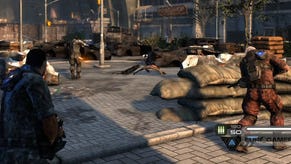Inversion
Dancing on the ceiling.
Over time, this should hopefully add a little bit of sparkle to the level design. It certainly makes things pleasantly chaotic – particularly since enemies can wield Gravlinks too, which means they can pull off all the same tricks that you can. On top of that, it helps that so much of Inversion's world is just itching to explode - the laws governing physics may have been busted, but the laws governing the behaviour of red oil drums have proved very resilient – and within seconds of going into any fire fight you're roadie-running between pieces of fragmenting cover while the air grows thick with floating crates, blobs of lava, and the remains of somebody else's arms and legs. Ouch.
Beyond the Gravlink, you can look forward to zero-gravity areas, similar to those in Dead Space, which see you boosting from one floating chunk of rock to the next, and vector shifts. These are specific points in each level that let you bound cheerily between planes. Whether you're leaving the floor to duke it out on the roof or bouncing from wall to wall inside a crumbling cavern, such moments should add a nice touch of wonky spectacle to proceedings, and the game undeniably works a little sub-Escher magic on you as it sends armies waltzing – well, okay, maybe not waltzing exactly – up the outside of skyscrapers, or spilling across the ceiling towards your position. There's potential for plenty of fun with explosives that roll from one plane onto another, and the game should be able to wring some nice brain-unravelling set-pieces from the whole business. Over the long term, though, it's hard to tell how much more entertaining it is to shoot someone when they're halfway up a wall as opposed to when they're standing on the floor. You just aim a bit higher, really.
What could be the saving grace of Inversion is actually a far more traditional use of gravity: its environments are rigged to break into pieces, and there's a simple pleasure to be had in dismantling things with bullets, and then sitting back to watch it all fall – sometimes usefully, sometimes just because we never seem to tire of watching big things topple over and smash. Beyond these base delights, however, Inversion's a weird mix of the ambitious and the placeholder. It's more enthusiastic about gravity than any game since Half-Life 2, but much of its world – with its cover, its dereliction, its beefy no-neck minions of death - could belong to a dozen other shooters, and that might be a problem come release day.






.png?width=291&height=164&fit=crop&quality=80&format=jpg&auto=webp)




.jpg?width=291&height=164&fit=crop&quality=80&format=jpg&auto=webp)